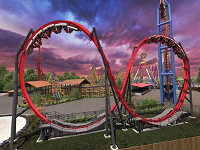What Is Welding Defects For Rides Amusement Park
Welding defect refers to the phenomenon that the metal produced by welding is discontinuous, not dense or poorly connected during the process of welding joints. Welding defects can be divided into the following six categories according to their characteristics:



(1) Crack (code 100) A defect produced by localized fracture in the solid state, which may arise from cooling or stress effects. According to the location and state of the crack, it is divided into:
1) Micro cracks (code 1001): cracks that can only be observed under a microscope.
2) Longitudinal cracks (code 101): cracks substantially parallel to the axis of the weld (see Figure 2-14). It may be located in: weld metal (code 1011), fusion line (code 1012), heat affected zone (code 1013), parent metal (code 1014).
3) Transverse cracks (code 102): cracks that are basically perpendicular to the axis of the weld .It may be located in: weld metal (code 1021), heat affected zone (code 1023), parent metal (code 1024).
4) Radial cracks (code 103): Radial cracks with a common point . It may be located in: weld metal (code 1031), heat affected zone (code 1033), parent metal (code 1034).
5) Crater cracks (code 104): Cracks at the weld crater. It may be longitudinal (code 1045), transverse (code 1046), radial (star crack, code 1047).
6) Intermittent crack group (code 105): A group of cracks distributed intermittently in any direction. It may be in the weld metal (code 1051), heat affected zone (code 1053), parent metal (code 1054).
7) Dendritic cracks (code 106): Crack groups originating from the same crack and connected together, which are obviously different from intermittent crack groups and radial cracks. It may be located in: weld metal (code 1061), heat affected zone (code 1063), parent metal (code 1064).



(2) Cavities (code 200) Cavities are divided into air holes and shrinkage holes.
1) Stomata (code 201): The pores formed by the residual gas. Specifically divided into the following categories:
① Spherical pores (code 2011): approximately spherical pores.
② Uniformly distributed pores (code 2012): some pores evenly distributed in the entire weld metal, different from chain pores (code 2014) and local dense pores (code 2013).
③ Locally dense stomata (code 2013): a group of stomata with arbitrary geometric distribution.
④Chain air holes (code 2014): a series of air holes parallel to the axis of the weld.
⑤ Bar-shaped air hole (code 2015): a non-spherical long air hole whose length is parallel to the axis of the weld.
⑥ Worm-shaped pore (code 2016): a tubular pore formed in the weld metal due to gas escape. Its shape and location are determined by the method of solidification and the source of the gas. Usually such pores are clustered in clusters and have the shape of a herringbone. Some worm gas may be exposed on the weld surface.
⑦ Surface pores (code 2017): pores exposed on the surface of the weld.
2) Shrinkage cavities (code 202): cavities caused by 2016 shrinkage during solidification.
①Crystal shrinkage hole (code 2021): The elongated shrinkage hole formed between the dendrites during the cooling process may have residual gas. This defect is usually found in the perpendicular to the weld surface.
②Arc crater shrinkage (code 2024): the concave hole at the end of the weld bead, which is not eliminated by the subsequent weld bead.
③ Shrinkage hole at the end of the arc crater (code 2025): reduce the exposed shrinkage hole in the cross section of the weld.



3)Amusement equipment Micro shrinkage cavities (code 203): shrinkage cavities that can only be observed under a microscope.
①Micro-crystal shrinkage cavities (code 2031): elongated shrinkage cavities formed between dendrites along grain boundaries during cooling.
②Miniature transgranular shrinkage cavity (code 2032): The elongated shrinkage cavity formed through the grain boundary during solidification.
(3) Solid inclusions (code 300) remaining in the weld metal.
1) Slag inclusion (code 301): slag remaining in the weld metal. Depending on how they are formed, these slag inclusions may be: linear (code 3011), isolated (code 3012), or clustered (code 3014).




2) Flux slag (code 302):Amusement equipment flux slag remaining in the weld metal. Depending on how they are formed, these inclusions may be: linear (code 3021), isolated (code 3022), or clustered (code 3024).
3) Oxide inclusions (code 303): metal oxides remaining in the weld metal during solidification. Such inclusions may be: linear (code 3031), isolated (code 3032), clustered (code 3033).
4) Wrinkle (code 3034): In some cases, especially when welding aluminum alloys, a large amount of oxide film is produced due to the dual effects of poor welding pool protection and turbulence.
5) Metal inclusions (code 304): foreign metal particles remaining in the weld metal. It may be: tungsten (code 3041), copper (code 3042) or another metal (code 3043).




(4) Incomplete fusion and incomplete penetration include incomplete fusion, incomplete penetration and nail tip.
1) Unfused (Code 401): The unbonded part between the weld metal and the base metal or the weld layers of the weld metal. Its possible forms are: sidewalls are not fused (code 4011), welds are not fused (code 4012), and the roots are not fused (code 4013).
Incomplete penetration (code 402): The difference between the actual penetration and the nominal penetration, as shown in Figure 2-32. Incomplete root penetration (code 4021) means that one or both fusion surfaces of the root are not melted.
Nail tip (code 403): extremely uneven penetration caused by electron beam or laser welding, in a sawtooth shape. Its possible forms include cavities, cracks, shrinkage cavities, etc.
Poor shape and size Poor shape (code 500) refers to the poor shape of the outer surface of the weld or the geometry of the joint.
Undercut (501): The irregular notch of the base metal (or the previous deposited metal) due to welding at the weld toe.
①Continuous undercut (code 5011): Undercut with a certain length and no interruption.
②Intermittent undercut (code 5012): Intermittent undercut with short length along the weld.
③ Shrinkage groove (code 5013): grooves that can be observed on each side of the root bead.
④ Undercut between weld beads (code 5014): longitudinal undercut between weld beads.
⑤ Partially staggered undercut (code 5015): On the side 5012 or the surface of the weld bead, there is an irregularly interrupted undercut with a short length.
2) Super high weld (code 502): The weld metal on the butt welding surface is too high.
3) Excessive convexity (code 503): The weld metal on the fillet weld surface is too high.
4) Slumping (code 504): Excessive weld metal protrudes to the root of the weld. The collapse may be: partial collapse (code 5041), continuous collapse (code 5042), melt-through (code 5043).
5) Poor weld shape (code 505): The included angle a between the surface of the base metal and the cut surface of the weld near the weld toe is too small.
6) Weld flash (code 506): Excessive weld metal covering the surface of the base metal but not fused with it. The weld bead may be weld toe weld (code 5061, that is, the weld at the toe), root weld (code 5062, that is, the weld at the root of the weld).
7) Wrong side (code 507): When the surfaces of the two weldments should be aligned in parallel, the deviation caused by not meeting the specified parallel alignment requirements. The wrong side may be: the wrong side of the plate (code 5071, the weldment is a plate), the wrong side of the pipe (code 5072, the weldment is a pipe).
8) Angle deviation (code 508): The two weldments are not parallel (or not aligned according to the specified angle), resulting in a deviation.
9) Sagging (Code 509): The weld metal slumps due to gravity. Sagging may be: horizontal sag (5091), flat position or overheat position sag (5092), fillet weld sag (5093), weld edge melt sag (5094).
10) Burn through (code 510): The collapse of the weld pool causes holes in the weld.
11) Not fully welded (code 511): Longitudinal continuous or discontinuous grooves are generated on the surface of the weld due to insufficient welding filler metal deposition.
12) Asymmetric welding feet (code 512).




13) Uneven width of the weld (code 513): The width of the weld varies too much.
14) Irregular surface (code 514): The surface is excessively rough.
15) Root shrinkage (code 515): Shallow groove due to butt weld root shrinkage.
16) Root pores (code 516): Porous pores formed at the root of the weld by gas evolution from the weld metal at the moment of solidification.
17) Poor weld joint (code 517): The local surface of the weld joint is irregular. It may occur in: cover flue (code 5171) or bottom weld (code 5172).
18) Excessive deformation (code 520): The dimensional deviation exceeds the standard due to welding shrinkage and deformation.
19) Incorrect weld size (code 521): Deviation from the pre-specified weld size. ①The thickness of the weld is too large (code 5211): the thickness of the weld exceeds the specified size.
②The width of the weld is too large (code 5212): the width of the weld exceeds the specified size.
③Insufficient effective thickness of the weld (code 5213): The actual effective thickness of the fillet weld is too small.
④ The effective thickness of the weld is too large (code 5214): the actual effective thickness of the fillet weld is too large.



(5) Other deficiencies (code 600) All other deficiencies not included above.
1) Arc scratches (code 601): Local damage to the surface of the weld adjacent to the base metal due to arcing or arcing outside the groove.
2) Splash (code 602): Particles that are splattered from the weld metal or filler material during welding (or weld metal solidification). Tungsten Splash (Code 6021): Tungsten particles that transition from the tungsten electrode to the surface of the base metal or solidify the weld metal.
3) Surface Tear (Code 603): Surface damage caused when temporary welding attachments are removed.
4) Wear scars (code 604): Local damage caused by grinding.
5) Gouge marks (code 605): Local damage caused by the use of a flat shovel or other tools.
6) Excessive grinding (code 606): Excessive grinding results in insufficient thickness of the workpiece.
7) Defects in tack welding (code 607): Defects caused by improper tack welding, such as: weld bead damage or lack of fusion (code 6071), welding is performed if the positioning does not meet the requirements (code 6072).
8) Double bead staggered (code 608): The centerlines of the weld beads welded on both sides of the joint are staggered.
9) Temper color (oxide film can be observed) (Code 610): Slightly oxidized surface produced in stainless steel welded area.
10) Surface scale (code 613): Severely oxidized surface of the weld zone.
11) Flux Residues (Code 614): Flux residues are not completely removed from the surface.
12) Residue (code 615): Residue is not completely removed from the weld surface.
13) Poor root clearance of fillet welds (code 617): The clearance between the workpieces to be welded is too large or insufficient.
14) Expansion (code 618): Defects caused by heating of light metal joints due to prolonged holding time in the solidification stage.



When the International Institute of Welding (IIW) evaluates radiographs, the corresponding reference code system is generally used for cracks that occur during or after welding, as shown in Table 2-9.
Table 2-9 Types and descriptions of welding cracks
| reference code | name and description | reference code | name and description | reference code | name and description | reference code | name and description |
| E | Weld cracks | Ed | precipitation hardening cracks | Eh | Shrinkage crack | EI | Aging cracks (nitrogen diffusion cracks) |
| Ea | hot crack | Ee | age hardening cracks | Ei | hydrogen induced cracking | ||
| Eb | solidification crack | Ef | cold crack | Ej | laminar tear | ||
| Ec | Liquefaction crack | Eg | brittle crack | Ek | Weld toe crack |







